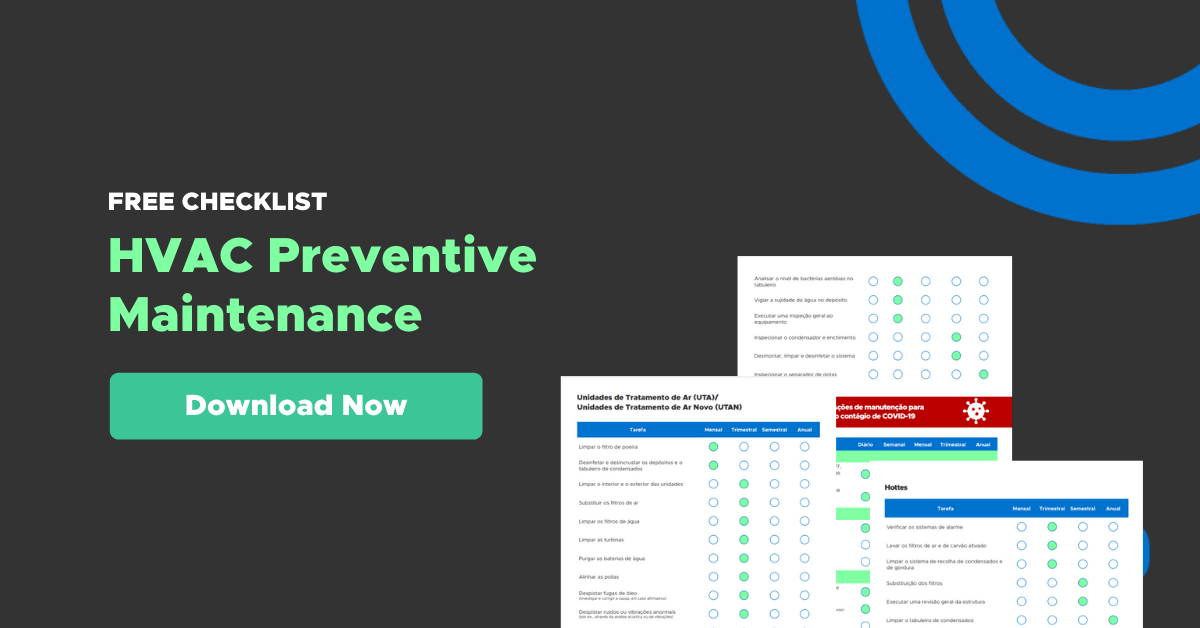As we realised during the COVID-19 pandemic, heating, ventilation, and air conditioning (HVAC) equipment plays a major role in maintaining indoor air quality and avoiding disease.
And, as we have seen in other articles on Facility Management, indoor air quality and relative humidity influence the users’ well-being and even the productivity of those who work on site. Therefore, as a complement to preventive maintenance interventions, we give you some HVAC tips to improve air quality and prevent disease.
How to improve indoor air quality with HVAC maintenance
Most buildings have mixed ventilation: part of the ventilation is natural (through windows, grills, and chimneys) and part is mechanical, with the help of extractors and ducts. If the maintenance of this mechanical ventilation fails, dampness, mould, and harmful particles accumulate.
Here are some tips to improve ventilation and air quality in buildings:
- The temperature should be in a range of 20-24°C in winter and 24-27°C in summer. The relative humidity should be between 40 and 60%. According to ASHRAE, ventilation rates depend on the occupancy type of the space. Check here the recommended minimums for hotels and office buildings, for example.
- Perform an Indoor Air Quality (IAQ) audit according to physicochemical and bacteriological parameters.
- Cleaning the ventilation and air conditioning ducts prevents the circulation of mould, dust, and harmful particles. In addition to preventive maintenance, there are several more intensive methods to remove debris, including mechanical agitation techniques, compressed air systems, or cleaning robots.
- Install an online IAQ monitoring system with a device that monitors the levels of volatile organic compounds (VOC), carbon dioxide, carbon monoxide, humidity, particulates (such as PM 2.5), pressure, temperature, and radon. Infraspeak’s platform, for example, integrates with Airthings, which lets you know all these values in real time.
- Plants can help reduce the levels of chemicals indoors. The hypothesis was proposed by NASA in 1989 when investigating ways to purify the air of the International Space Station. There are still no studies to prove that it is an effective method in homes and office buildings. But given that there are so many benefits to plants, it doesn’t hurt to try!
How to prevent the spread of disease with HVAC maintenance
First, we remind you that air conditioning does not spread diseases like COVID-19 or other similar viruses. The real danger is spaces without ventilation, whether mechanical or natural. With proper maintenance and filtering equipment, the HVAC system only brings filtered air into the building and extracts potentially contaminated air to the outside. In other words: it is perfectly safe.
- Keep mechanical ventilation always running, even at times of day with low occupancy.
- Install an air purification system (APU) or portable recirculation air purification units, especially in higher risk areas.
- Filter the air using HEPA filters (High Efficiency Particulate Arrestance). As the name suggests, these are highly efficient filters which eliminate viruses and bacteria. In fact, it is these filters that aircraft use to prevent the spread of pathogens through recirculated air. As filters need to be washed or changed frequently, be sure to create this planned task in your software.
- Using UV disinfection technology and ionising radiation in combination with HEPA filters can further increase the virus-killing capacity. Like filters, this technology should be inside the ducts to prevent the contamination of the indoor air.
- Apply bactericidal, algaecide, and fungicidal tablets to the system’s condensate water every 2-4 months. These continuous treatment tablets prevent the proliferation of microorganisms and pathogens, including Legionella. If you set an alert on your maintenance platform, you’ll never forget to disinfect again!
🦠 Worried about Legionella? Download our anti-Legionella preventative maintenance plan and don’t let this bacterium take hold in your hot tubs, pools, and hot water network.
- Monitor the air flow rate, air velocity, and the direction of the discharged air. The velocity should be less than 0.2 m/s to avoid draughts (thermal comfort) and reduce the risk of particles moving from one part of the room to another (prevent diseases). The total airflow volume should be set according to the capacity of the equipment, generally with a ratio of 1.6 – 3.2 m3/kW of cooling.
- Determine the best airflow for each room to improve air distribution. Ideally, there is an air outlet in one place that ensures good airflow but does not push air directly into the occupied space (creating localised cooling and putting those people at greater risk). The air must move and expand before it reaches the room.
- Evaluate the location of outdoor air inlets and air expulsion ducts to avoid contamination on the outside of the building.
Is HVAC maintenance a puzzle for you? Download our free HVAC maintenance checklist for a quick refresh of all the best practices. That way you keep your buildings more comfortable, safer, and healthier!


